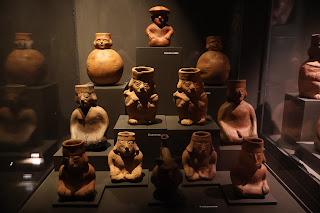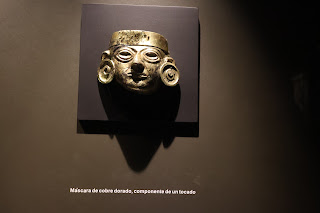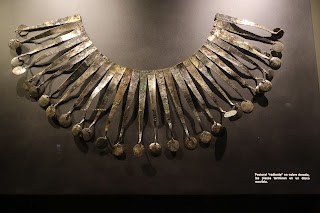On the first floor, the main axis is the reproduction of the Funerary Chamber
of the Lord of Sipan, open on one side to allow the visitor to see all its
contents.
On this floor, the lower-ranking tombs discovered on the funerary platform are
presented, each of which is documented with graphics of its location,
excavation and display cases that show the most representative archaeological
evidence to explain the functions in life of those who were buried and their
hierarchy in Moche society.
The largest space on this floor is dedicated to the Tomb of the Old Lord of
Sipan, the oldest ruler of the royal mausoleum, where the first findings of
offering deposits are displayed, jewels of great splendor such as the necklace
with 10 representations of spiders in gold to continue with other ornaments
and materials from the first layers of the funerary trousseau where the image
of the anthropomorphized feline, the crab man and the pectoral representing
the tentacles of an octopus stand out.
Two important themes that are exhibited on this floor are related to the
looted tomb and the international recoveries that seek to reflect on the
looting, trafficking and risks of our cultural heritage.
|
Plan of the first floor of the museum.
|
|
Descending to the lower level
Descending to the lower level of the Lord's burial chamber, the Old
Lord's tomb and other burials.
|
|
The companions
On the first level, around the coffin, were the remains of four
companions and a dog. Each character, in life, fulfilled specific
functions in the royal environment of the Lord.
- Standard bearer
- Woman (Main)
- Military Chief
- Woman
|
|
Copper crown
Copper crown belonging to the Lord's chief wife.
-
It was intentionally folded to facilitate its placement in the coffin.
|
|
The face of the Lord of Sipan
Approximate recreation of the face of the Lord of Sipan.
- Developed based on forensic anthropology research.
|
|
Vessels for offerings and prayers
|
|
Noble, warriors and prisoners
- Top: Noble prayer.
- Center: Warriors.
- Bottom: Prisoners.
|
|
The remains of the Lord of Sipan
The remains of the Lord of Sipan, in his final resting place.
|
The Old Lord
|
The Old Lord
Studying the architectural characteristics of the construction, an
intact tomb was discovered, located six meters deep and associated with
the first stage of the platform.
-
Upon verifying the content and complexity of the funerary trousseau,
its occupant was called "The Old Lord of Sipan", in recognition of his
evident rank and greater antiquity.
|
|
Vessels representing warriors
On the surface levels, arranged in a symbolic formation, vessels
representing warriors were found.
- Eight figures with amputated arms and simple jugs.
- Bones of amputated arms and feet were also found nearby.
|
|
Part of the tomb ornaments and offerings
|
|
Spider necklace
Each piece of the necklace demonstrates the exquisite antiquarian
conception of a spider on its loom of gold threads.
-
Made of six pieces of laminated and embossed metal, finally joined by
more than one hundred welding points.
-
A real feat by the Mochica jewelers for one of the royal ornaments of
the Old Lord.
|
|
Detail of the spider necklace
Necklace of ten gold pieces that represent spiders carrying the face of
a character on their belly.
-
On the back there are stylized helical reliefs depicting snakes with
bird heads, representing the deity of water and wind.
-
This is one of the most spectacular jewels of Mochica goldsmithing.
|
|
Use of the necklace
Use of the necklace representing spiders.
|
|
First set of funerary trousseau
|
|
Copper mask
Copper mask representing the deity.
- It was found among the bunch of weapons.
|
|
Wooden arrow or dart launcher
Wooden arrow or dart launcher carved with a bird's head and metal sling.
|
|
Ornament representing Ai-apaec
Parts of an ornament representing Ai-apaec, surrounded by serpent heads.
|
|
Gilded copper mask
Gilded copper mask, component of a headdress.
|
|
Military emblem
Probable use of this ornament as a military emblem.
|
|
Religious image
How this religious image was carried.
|
|
Schematic reconstruction
Schematic reconstruction of the funerary trousseau of the “Old Lord of
Sipan”.
-
On the body were arranged his ornaments, emblems, clothing, symbols of
rank and authority.
- Blankets of cotton and plant fiber closed the funerary bundle.
- To the right, a bunch of metal spears.
- In the corner, shell offerings and a llama head.
- The floor of the tomb was covered with red pigment.
-
At the head of the bundle were placed the bodies of a woman and a
llama.
|
|
Reproduction of the tomb
Reproduction of the tomb of the “Old Lord of Sipan” in one of its most
representative levels.
|
|
The remains of the “Old Lord of Sipan”
The remains of the “Old Lord of Sipan” in his final resting place with
the original vessels that surrounded the funerary bundle.
-
The tomb of this royal personage, despite its smaller dimensions, was
as rich and complex as the first lord discovered.
-
Many of the symbols of rank and power were similar or alike.
Evidently, it was his predecessor.
-
The comparison of the form of burial and characteristics of the
emblems demonstrate cultural changes. In his time, the Old Lord
concentrated political and religious functions that were later
separated.
-
Recent DNA tests show that both lords belonged to a single royal
family.
|
|
Nosepiece and tweezers
-
Top: Embossed silver nosepiece, representing stylized bird heads.
-
Bottom: Copper tweezers used by the Old Lord to shave his beard.
|
|
The pectoral
The pectoral symbolizes a clean and restored octopus.
- It was made from pieces of copper, gilded copper and silver.
-
The center row represents snake heads with a golden sphere in their
mouths.
-
The silver pieces imitate shell cutouts, the funerary mask lacks the
left eye, symbolically removed at the time of burial.
|
|
Hypothetical reconstruction
Hypothetical reconstruction of the ornament on the chest of the Old Lord
of Sipan.
|
|
Deity of the sea
A supernatural creature, a mixture of man and crab, a deity of the sea.
-
It was made from pieces of gilded copper inlaid with shells and
stones.
|
|
Mythical battles
In Mochica art, this character appears in mythical battles with the
Ai-Apaec.
|
|
Gold earmuffs
Gold earmuffs with flaps that vibrate when they move.
- They were made from embossed, laminated and soldered sheets.
|
|
Gold and silver scepters
-
Right: Golden scepter carried by the Old Lord of Sipan, it is said to
represent a mythical fruit. It has a sound mechanism and the blade
ends in a sharp knife for ceremonial use.
-
Left: Cast silver scepter with the image of a character crowned with
two-headed serpents. It was the symbolic counterpart of the golden
scepter.
|
|
Coxal protectors
Set of coxal protectors or coxaleras made of gilded copper, made
from embossed and openwork sheets, representing the iguana, the animal
linked to the world of the dead.
|
|
Banner
These banners were made from gilded copper strips, originally sewn onto
a cotton cloth.
-
Due to corrosion, some have lost the gold plating that covered their
surface.
|
|
Banner
Sets of metal banners, similar to those found in the tomb of the first
Lord discovered, also represent a character with outstretched arms,
protruding eyes and a body covered in flaps.
-
He was called the “deity of the ulluchos”, in allusion to the mythical
fruit (not yet identified) that surrounds the image.
|
|
Third set of funerary trousseau
|
|
Fox's head
Representation of a fox's head in copper.
- Part of the Old Lord's combat headdress.
- The eyes were inlaid with shell.
- An ingenious mechanism allowed the tongue to move.
|
|
“Radiant” pectoral
“Radiant” pectoral in gilded copper, the plates end in a movable disc.
|
|
Silver-plated copper mask
Silver-plated copper mask with headdress and necklace of owl heads.
-
The turquoise inlay on the left eye was also symbolically removed.
- It could represent the face of the Old Lord.
|
|
Fourth set of funerary trousseau
|
|
Gilded copper bells
Gilded copper bells decorated with a scroll.
- They were used for ceremonies and parades.
|
|
Ritual rattles
Set of ten ritual rattles made of gilded copper.
-
They must have been used hanging from the body or from some accessory.
|
|
Second gold necklace
A second gold necklace is made up of ten feline faces with shell-inlaid
teeth, a symbol of power and divinity.
-
The back has engravings of snakes with bird heads in a helical
arrangement.
|
|
Gold rattles
Set of ten gold rattles depicting the Ai-Apaec.
|
|
Silver heads
Silver heads belonging to a necklace, representing semi-feline faces.
|
|
Representations of naturalistic human faces
Representations of naturalistic human faces, which together with the
previous sets could indicate a process of mythical transfiguration, from
man to man-feline.
|
|
Nose ring
The most exquisite jewel of the Old Lord of Sipan was this nose ring of
gold, silver and turquoise, representing his possible miniature image
with weapons and the headdress of an owl with open wings.
- The metal feathers vibrate with movement.
|
|
Set of gold and silver nose rings
Set of gold and silver nose rings with various decorations and shapes.
-
Each one of them shows complex goldsmithing techniques, such as
lamination, embossing, gold on silver settings or bimetallic
combinations.
-
They must have been used by the dignitary for different ceremonies.
-
In the centre, solid masses of gold and silver, found on the face
inside the mouth and hands.
|
|
Shell pectorals
Continuing with the record of the ornaments placed on the body, two
shell pectorals and other sets of silver necklaces were recovered.
|
|
Coxal protector
Coxal protector or coxalera, with the image of a divinity.
-
This gold ornament (and the rattles) were reserved for sovereigns.
|
|
Necklace depicting ten heads of old men
Necklace depicting ten heads of old men in gold.
- They are said to be related to the cyclical game of life.
-
They were made using two embossed and soldered parts with an alloy of
gold, silver and copper.
|
|
Shell pectoral
Shell pectoral, made of double tubular pieces forming volutes, a symbol
of water.
|
|
Banner
Like the first royal tomb, the banners, made of gilded copper with the
"deity of the ulluchos", located below the body, also symbolically
looked downwards.
|
|
Metal covers of combat weapons
Metal covers of combat weapons, intentionally disassembled and crushed.
-
Probably military trophies or belongings symbolically annulled at the
time of burial.
-
They were found at the foot of the funerary bundle of the Old Lord of
Sipan.
|
|
Reconstructed image of the “Old Lord of Sipan”
Reconstructed image of the “Old Lord of Sipan” with one of his sets of
outfits and symbols of power.
- He was the oldest hierarch buried on the funerary platform.
|
See also
Source
Location
Royal Tombs of Sipan Museum
Royal Tombs of Sipan Museum - Third Floor
Royal Tombs of Sipan Museum - Second Floor
Royal Tombs of Sipan Museum - Royal House




















































































































